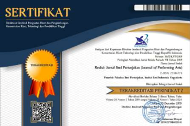Pola Irama Keroncong Progresif - Pada Komposisi Kidung Panyuwun
Abstract
Abstract
This research creates a progressive or innovative keroncong rhythm pattern. Keroncong music is one of the musical genres that exist in Indonesia, which is a hybrid music from Javanese (Central Java and Yogyakarta) gamelan music, 'pop' music and Western diatonic orchestras. Keroncong music consists of vocals, ukulele or 'cuk' (derived from Hawai'i), 'cak' (Portugal), flute, violin, cello, and contrabass (instruments derived from Western diatonic orchestral instruments). Since the 1950s until today, the keroncong rhythm pattern has had very little development, so it needs to be developed. There are several rhythm patterns in keroncong music but the ones that are often played are 'engkel' and 'double' rhythm patterns. The aim of this research is to create a progressive keroncong rhythm pattern so that keroncong music is more interesting and it is hoped that it will have more fans. The creation of this progressive rhythm pattern is used in the compositions of the author's Kidung Panyuwun. This study used descriptive and experimental analytical methods with the following steps. First, examine the audio recording, transcribe, analyze, and conclude; second analyzes rhythm patterns on multiple references; the third records (audio-video) a 'standard' rhythm pattern; fourth, exploration of progressive rhythm patterns; the fifth recorded a progressive keroncong rhythm pattern. This research resulted in the creation of several rhythmic patterns and several formulations, namely: 1) the creation of a vertical progressive keroncong rhythm pattern (one-instrument solo, two-instrument solo, three-instrument solo) and 2) the creation of a horizontal progressive keroncong rhythm pattern (two-bar pattern and four-dimensional pattern). time frame). The important thing that has the meaning is the temuah cirikhas or 'ruh' keroncong music as the 'jati diri'.
Keywords: rhythm; pattern; keroncong; progressive
Abstrak
Penelitian ini menciptakan pola irama keroncong progresif atau inovatif. Musik keroncong merupakan salah satu genre musik yang ada di Indonesia merupakan musik hibrid dari karawitan Jawa (Jawa Tengah dan Yogyakarta), musik ‘pop’ dan orkestra diatonis Barat. Musik keroncong terdiri dari vokal, ukulele atau ‘cuk’ (berasal dari Hawai’i), ‘cak’ (Portugal), flute, biola, cello, dan contrabass (merupakan instrumen-instrumen yang berasal dari instrumen orkestra diatonis Barat). Sejak tahun 1950-an sampai hari ini, pola irama keroncong sedikit sekali perkembangannya sehingga perlu dikembangkan. Ada beberapa pola irama dalam musik keroncong tetapi yang sering dimainkan hanya pola irama ‘engkel’ dan ‘dobel’. Tujuan penelitian ini untuk menciptakan pola irama keroncong progresif sehingga musik keroncong lebih menarik dan diharapkan lebih banyak penggemarnya. Penciptaan pola irama progresif ini digunakan pada komposisi Kidung Panyuwun ciptaan penulis. Penelitian ini menggunakan metode analitik deskriptif dan eksperimental dengan lankah-langkah sebagai berikut. Pertama mencermati rekaman audio, mentranskrip, menganalisis, dan menyimpulkan; kedua menganalisis pola irama pada beberapa referensi; ketiga merekam (audio-video) pola irama ‘pakem’; keempat eksplorasi pola irama progresif; kelima merekam pola irama keroncong progresif. Penelitian ini menghasilkan beberapa ciptaan pola irama dan beberapa formulasi, yaitu: 1) penciptaan pola irama keroncong progresif vertikal (solo satu instrumen, solo dua instrumen, solo tiga instrumen) dan 2) penciptaan pola irama keroncong progresif horizontal (pola dua birama dan pola empat birama). Hal penting yang bermakna adalah temuah cirikhas atau’ruh’ musik keroncong sebagai ‘jatidiri’nya.
Kata kunci: pola irama; keroncong; progresif
Keywords
Full Text:
PDFReferences
Alfian, M. (2013). Keroncong Music Reflects the Identity of Indonesia. Tawarikh-International Journal for Historical Studies, 4(2), 171-186. https://mindamas-journals.com/tawarikh/article/view/555
Bramantyo, T. (2018). Early Acceptance of Western Music in Indonesia and Japan. Arts and Social Sciences Journal, 9(5). https://astonjournals.com/manuscripts/Vol_9_2018/ASSJ_Vol9_5_early-acceptance-of-western-music-in-indonesia-and-japan-2151-6200-1000408.pdf
Dallin, L. (1984). Techniques of Twentieth Century Composition - A Guide to the Materials of Modern Music, WM. C. Brown Company Publishers, California - USA.
Ganap, V. (2006). Pengaruh Portugis pada Musik Keroncong. Harmonia Journal of Arts Research and Education, 7(2). https://doi.org/10.15294/harmonia.v7i2.753
Hendry, Y. (2011). Musik Keroncong Campur Sari dalam Pluralitas Budaya Masyarakat Sawahlunto. Resital Jurnal Seni Pertunjukan, 12(1), 84-95. https://doi.org/10.24821/resital.v12i1.468
Jayantoro, S. (2019). Tranformasi Konfrontatif Komposisi Gamelan Baru: Revitalisasi Penciptaan Inovatif dan Peran Vital Perguruan Tinggi Seni. Keteg: Jurnal Pengetahuan, Pemikiran, dan Kajian Tentang Bunyi, 18(1), 25-38. https://doi.org/10.33153/keteg.v18i1.2394
Kristiana, N. N. D. (2015). Kajian Tekstual The Drupadi Trilogy Karya Ananda Sukarlan. Jurnal Kajian Seni, 2(1), 78-94. https://doi.org/10.22146/art.11651
Persichetti, V. (1961). Twentieth Century Harmony Creative Aspects and Practice. Faber And Faber Limited. London.
Prakosa, G. R., & Haryono, S. (2012). Improvisasi Permainan Cello Pada Permainan Irama Jenis Langgam Jawa Grup Orkes Keroncong. Harmonia Journal of Arts Research and Education, 1(1), 68-76. https://doi.org/10.15294/jsm.v1i1.1802
Rachman, A. (2013). Bentuk Dan Analisis Musik Keroncong Tanah Airku Karya Kelly Puspito. Harmonia Journal of Arts Research and Education, 13(1), 69-77. https://doi.org/10.15294/harmonia.v13i1.2534
Rachman, A., & Utomo, U. (2018). Sing Penting Keroncong. Jurnal Pendidikan dan Kajian Seni, 3(1), 47-63. http://dx.doi.org/10.30870/jpks.v3i1.4066
Ramadhani, F. A., & Rachman, A. (2019). Resitensi Musik Keroncong di Era Disrupsi: Studi Kasus Pada O.K Gita Puspita di Kabupaten Tegal. Musikolastika: Jurnal Pertunjukan dan Pendidikan Musik, 1(1), 41-51. https://doi.org/10.24036/musikolastika.v1i1.18
Romadona, E. A. (2019). Penciptaan Musik Keroncong Dan Wayang Inovatif Dalam Pertunjukan Congwayndut. Sorai: Jurnal Pengkajian Dan Penciptaan Musik, 12(1), 12-20. https://doi.org/10.33153/sorai.v12i1.2619
Sanjaya, S. (2013). Metode Lima Langkah Aransemen Musik. Promusika: Jurnal Seni Pertunjukan, 1(1), 33-49. https://doi.org/10.24821/promusika.v0i0.538
Sanjaya, S. (2018). New Composition Concept for Keroncong Music in the Oboe Concerto with Keroncong and Orchestra. IJCAS, 5(2), 75-85. https://doi.org/10.24821/ijcas.v5i2.2413
Soedarsono, R. M. (2001). Metode Penelitian Seni Pertunjukan dan Seni Rupa dengan Contoh-contoh untuk Tesis dan Dosertasi. Bandung: Masyarakat Seni Pertunjukan Indonesia.
Suneko, A. (2016). Pyang Pyung: Sebuah Komposisi Karawitan. Resital Jurnal Seni Pertunjukan, 17(1), 60-66. https://doi.org/10.24821/resital.v17i1.1690
Tranquada, J., & King, J. (2012). The ’Ukulele: A History. University of Hawa’I Press, Honolulu.
Widyanta, N. C. (2017). Efektifitas Keroncong Garapan Orkes Keroncong Tresnawara Teerhadap Audiensi Generasi Muda. Jurnal Kajian Seni, 03(02), 165-180. https://doi.org/10.22146/jksks.30042
Zandra, R. A. (2019). Keroncong Gaya Keempat (Kajian Bentuk dan Gaya Penyajian). JADECS (Jurnal of Art, Design, Art Education & Cultural Studies), 04(01), 39-47. http://dx.doi.org/10.17977/um037v4i1p39-47
DOI: https://doi.org/10.24821/resital.v22i1.4620
Refbacks
- There are currently no refbacks.
This work is licensed under a Creative Commons Attribution 4.0 International License.



